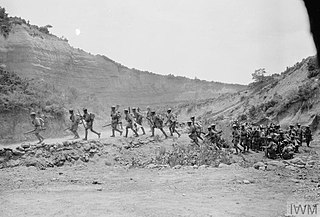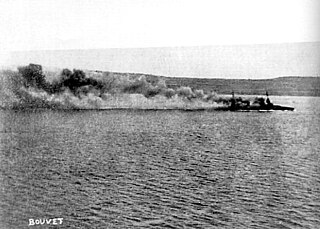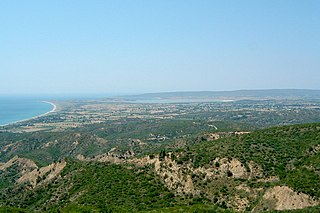
The Gallipoli campaign, the Dardanelles campaign, the Defense of Gallipoli or the Battle of Gallipoli was a military campaign in the First World War on the Gallipoli peninsula from 19 February 1915 to 9 January 1916. The Entente powers, Britain, France and the Russian Empire, sought to weaken the Ottoman Empire, one of the Central Powers, by taking control of the Ottoman straits. This would expose the Ottoman capital at Constantinople to bombardment by Entente battleships and cut it off from the Asian part of the empire. With the Ottoman Empire defeated, the Suez Canal would be safe and the Bosphorus and Dardanelles straits would be open to Entente supplies to the Black Sea and warm-water ports in Russia.

The 29th Division, known as the Incomparable Division, was an infantry division of the British Army, formed in early 1915 by combining various Regular Army units that had been acting as garrisons around the British Empire. Under the command of Major-General Aylmer Hunter-Weston, the division fought throughout the Gallipoli Campaign, including the original landing at Cape Helles. From 1916 to the end of the war the division fought on the Western Front in Belgium and France.

The New Zealand and Australian Division was a composite army division raised for service in the First World War under the command of Major General Alexander Godley. Consisting of several mounted and standard infantry brigades from both New Zealand and Australia, it served in the Gallipoli Campaign between April and December 1915.
The Battle of Sari Bair, also known as the August Offensive, represented the final attempt made by the British in August 1915 to seize control of the Gallipoli peninsula from the Ottoman Empire during the First World War.

The Battle of Hill 60 was one of the last major assault of the Gallipoli Campaign. It was launched on 21 August 1915 to coincide with the attack on Scimitar Hill made from the Suvla front by Major-General H. de B. De Lisle's British IX Corps, Frederick Stopford having been replaced in the few days previous. Hill 60 was a low knoll at the northern end of the Sari Bair range which dominated the Suvla landing. Capturing this hill along with Scimitar Hill would have allowed the Anzac and Suvla landings to be securely linked.
The Battle of Scimitar Hill was the last offensive mounted by the British at Suvla during the Battle of Gallipoli in World War I. It was also the largest single-day attack ever mounted by the Allies at Gallipoli, involving three divisions. The purpose of the attack was to remove the immediate Ottoman threat from the exposed Suvla landing and to link with the ANZAC sectors to the south. Launched on 21 August 1915 to coincide with the simultaneous attack on Hill 60, it was a costly failure, in which the Turks were forced to use all their reserves in "severe and bloody fighting" far into the night, with some Turkish trenches lost and retaken twice.

The Battle of Chunuk Bair was a World War I battle fought between the Ottoman defenders and troops of the British Empire over control of the peak in August 1915. The capture of Chunuk Bair,, the secondary peak of the Sari Bair range, was one of the two objectives of the Battle of Sari Bair.

The Second Battle of Krithia continued the Allies' attempts to advance on the Helles battlefield during the Battle of Gallipoli of the First World War. The village of Krithia and neighbouring hill of Achi Baba had to be captured in order for the British to advance up the Gallipoli peninsula to the forts that controlled passage of the Dardanelles straits. A small amount of ground was captured after two days of costly fighting, but the objectives remained out of reach.

The Third Battle of Krithia, fought on the Gallipoli peninsula during World War I, was the last in a series of Allied attacks against the Ottoman defences aimed at achieving the original objectives of 25 April 1915. The previous failures in the first and second battles resulted in a less ambitious plan being developed for the attack, but the outcome was another costly failure for the Allies. The allied aim was, as always, to facilitate the capture of Alçı Tepe which commanded most of the peninsula.

The Battle of Gully Ravine (Zığındere) was a World War I battle fought at Cape Helles on the Gallipoli peninsula. By June 1915 all thoughts the Allies had of a swift decisive victory over the Ottoman Empire had vanished. The preceding Third Battle of Krithia and the attack at Gully Ravine had limited objectives and had much in common with the trench warfare prevailing on the Western Front. Unlike previous Allied attacks at Helles, the Gully Ravine action was largely successful at achieving its objectives, though at a typically high cost in casualties.
The Battle of Krithia Vineyard was fought during the Gallipoli Campaign during the First World War. It was originally intended as a minor British action at Helles on the Gallipoli peninsula to divert attention from the imminent launch of the August Offensive, but instead, the British commander, Brigadier General H.E. Street, mounted a futile and bloody series of attacks that in the end gained a small patch of ground known as "The Vineyard".

The landing at Cape Helles was part of the Gallipoli Campaign, the amphibious landings on the Gallipoli peninsula by British and French forces on 25 April 1915 during the First World War. Helles, at the foot of the peninsula, was the main landing area. With gunfire support from the Royal Navy, the 29th Division was to advance six mi (9.7 km) along the peninsula on the first day and seize the heights of Achi Baba. The British then planned to capture the forts that guarded the straits of the Dardanelles.

SS River Clyde was a 3,913 GRT British collier built by Russell & Co of Port Glasgow on the Firth of Clyde and completed in March 1905. In the First World War the Admiralty requisitioned her for the Royal Navy and in 1915 she took part in the Gallipoli landings. After the war she was repaired and sold to Spanish owners, with whom she spent a long civilian career trading in the Mediterranean before being scrapped in 1966.

The naval operations in the Dardanelles campaign took place against the Ottoman Empire during the First World War. Ships of the Royal Navy, French Marine nationale, Imperial Russian Navy and the Royal Australian Navy, attempted to force a passage through the Dardanelles Straits, a narrow, 41-mile-long (66 km) waterway connecting the Mediterranean Sea with the Sea of Marmara and the Black Sea further north.
This article presents the timeline of the Gallipoli Campaign. The period of the proper battle is considered to be 19 February 1915 to 9 January 1916; however, a number of events took place between August 1914 and January 1915 that are relevant to the battle.

The landing at Suvla Bay was an amphibious landing made at Suvla on the Aegean coast of the Gallipoli peninsula in the Ottoman Empire as part of the August Offensive, the final British attempt to break the deadlock of the Battle of Gallipoli. The landing, which commenced on the night of 6 August 1915, was intended to support a breakout from the ANZAC sector, five miles (8 km) to the south.
Achi Baba is a height dominating the Gallipoli Peninsula in Turkey, located in Çanakkale Province. Achi Baba was the main position of the Ottoman Turkish defenses in 1915 during the World War I Gallipoli campaign. Mediterranean Expeditionary Force Commander-in-Chief Sir Ian Hamilton had set the capture of Achi Baba as a stated priority for operations during the Allied landing at Cape Helles on 25 April 1915. Four separate attempts were made by the Allies to seize Achi Baba and the village of Krithia between April and July, but the heights remained in Turkish hands for the duration of the campaign.
The Battle of Eski Hissarlik took place on 1 May 1915 and was an attempt made by the Ottomans, commanded by Liman von Sanders to push Allied troops back to the sea.

The Corps Expeditionnaire d'Orient (CEO) was a French expeditionary force raised for service during the Gallipoli Campaign in World War I. The corps initially consisted of a single infantry division, but later grew to two divisions. It took part in fighting around Kum Kale, on the Asiatic side of the Dardanelles, at the start of the campaign before being moved to Cape Helles where it fought alongside British formations for the remainder of the campaign. In October 1915, the corps was reduced to one division again and was finally evacuated from the Gallipoli peninsula in January 1916 when it ceased to exist.

The Battle of Kumkale was a World War I battle fought between Ottoman and French forces. It was a part of the Gallipoli Campaign fought on the Anatolian (Asian) part of the Dardanelles Strait as a diversion from the main landings on the Gallipoli peninsula. Kumkale is the name of a village which now is a part of Troy national park.














